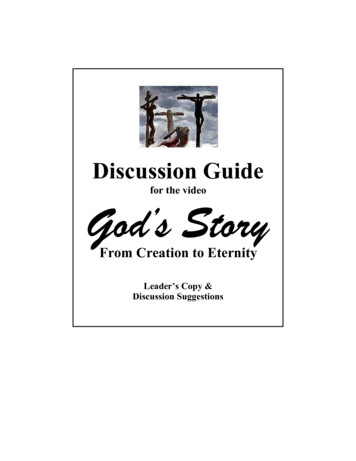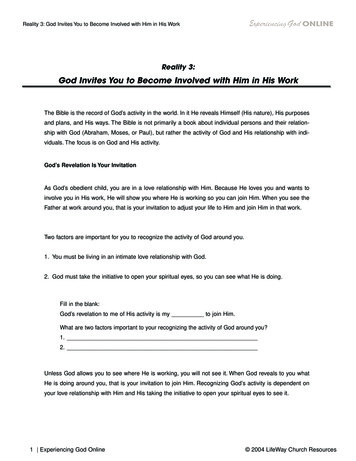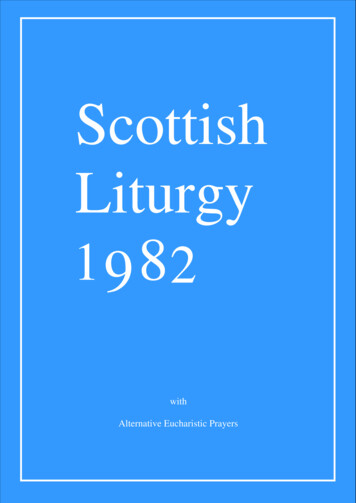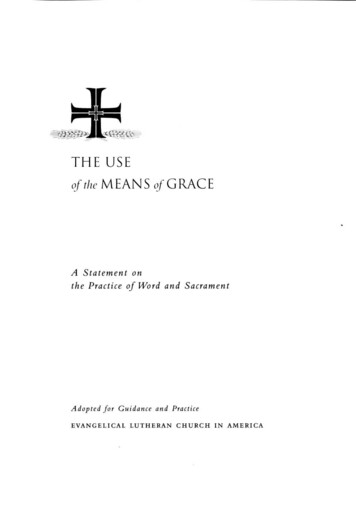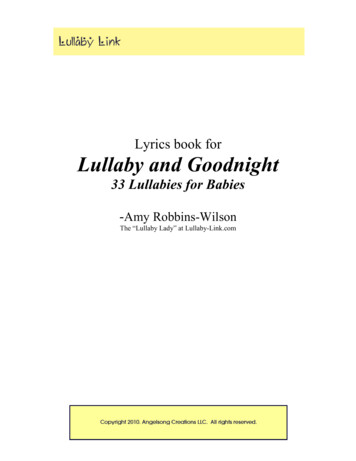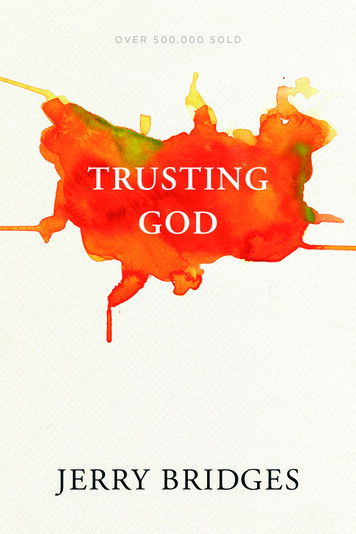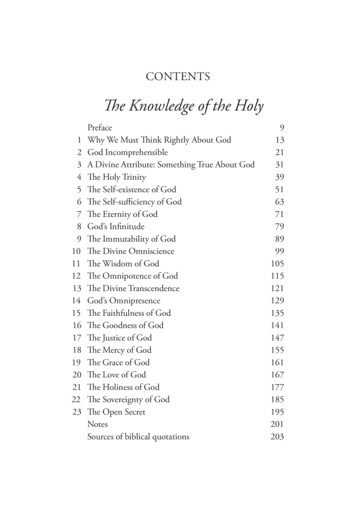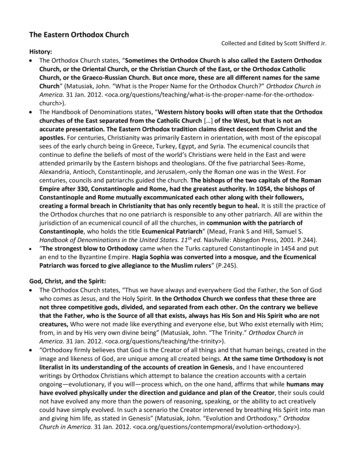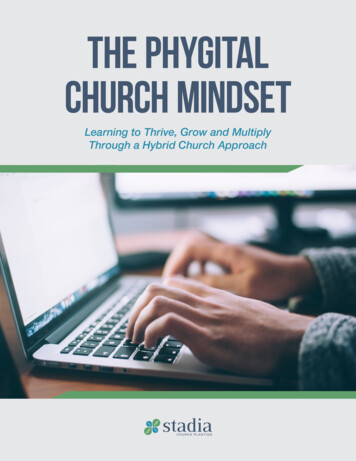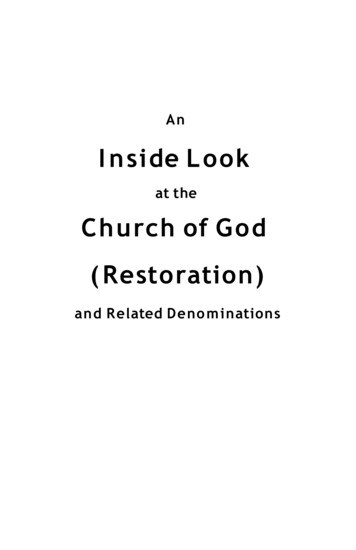
Transcription
AnI n side L ookat theChurch of G od( Restoration)and Related Deno minations
Introduction.1A brief look at the history of the Church of God.2D. S. Warner.2John Winebrenner and “The Church of God(Winebrennerian)”.4Back to Warner .9The new Church of God.10The Church of God after Warner.13Is the Church of God movement special in God’s eyes?. 14Treating point number one: it has the truth.15Treating point number two: The “Church of God” has aspecial prophetic place in the Scriptures.17The 2300 days of Daniel the Prophet.17The 1260 days of Revelation 11.19The mark of the Beast.20The “evening light”of Zechariah 14:7.20Is D. S. Warner infallible?.21A word about church history .22And sanctification .24Of sin and self.25Reformation, revival and quickening.26Emotionalism.27Some special words to any who are part of the Churchof God movement.30When should we “come out” of a fallen congregation?.33Conclusion.34Enter to learn, depart to serve.352
IntroductionSince our return to the USA about two years ago, I have had severalconversations along the following line—especially since the Church ofGod Restoration has recently held evangelistic meetings in mycommunity:“Say”, someone asks me, “have you ever heard of a group that callsthemselves ‘Church of God’”?“Yes”, I reply. “That is my church background.”“Really! I ran into someone the other day that said they are part ofthat group. I never heard of it before.”“My paternal grandfather and my maternal grandmother were Churchof God preachers”, I continue.“Oh? I never knew they existed before ”As the conversation continues, I usually hear the following question:“And if that is your church background, may I ask why you left it?”On a couple of occasions, at the end of the conversation, the person Ihave been talking to tells me that I should talk to so-and-so, as saidperson would be very interested to hear what I have shared. This paper isa way to do that; give a closer look at the Church of God movement.As mentioned, I grew up in the Church of God movement. By saying“movement”, I mean to say that, as I will explain later on, there areseveral sub-groups of churches that call themselves Church of God,which derive from the movement started by Daniel Sydney Warner in thelate 19th century. I have personal acquaintance with at least 8 differentbranches of this movement, of which the “Church of God (Restoration)”springs from.And, being an avid reader, I have read much church history andliterature from many other groups. What I write then, is not merelysomething that I “pop off the top of my head”. Since childhood (and Iam 39 years old at this writing) I have been searching and watching andcontemplating. By saying this, I do not want to say that I knoweverything about the Church of God movement—rather, I desire to let thereader know that what I say does not come from one or two visits to ameeting somewhere.I intend to point out some negative and some positive points of themovement. May each of us learn one from another. Were it not for theChurch of God movement, where would I be? My maternal grandmotherwas drawn from a life of sin and became a missionary to Nigeria. Mypaternal grandparents sought for something deeper than the superficialBaptist church they were a part of. Cousins on both sides of my family—cousins whose parents rejected the teachings of their parents—are1
druggies, fornicators, and adulterers (most are married to the second orthird companion). The message of holiness that the Church of Godtaught has kept me from a lot of sin and grief.With this in mind, I begin with A brief look at the history of the Church of GodI well remember driving down the street in Hartford City, Indiana 1one day and seeing the following inscribed in the cornerstone of aChurch of God building:The Church of God- founded A.D. 33It struck me as a bit hypocritical. I was only a young teenager , but Iknew that that particular branch of the Church of God had not beenfounded in A.D. 33. That branch of the Church of God was in apostasy—at least in my young mind.But in the minds of many Church of God people, their church doesindeed date back to the Pentecost. In their judgment, what they teach andpractice is exactly what the Apostles taught and practiced. To suggestthat their church was founded at a later date is almost tantamount toblasphemy.But the fact remains that the Church of God movement was begun inthe late 1800’s. Up until that time, there was no church group that taughtthe exact same doctrine and had the same practice. Therefore, it is onlyright to say that the Church of God began as a movement in the 19thcentury.Most Church of God people count Daniel Sydney Warner—usuallyreferred to as D. S. Warner—as the last reformer who finally broughtabout the perfect restoration of the New Testament church.D. S. WarnerOn June 25, 1842, Daniel Sydney Warner was born at Bristol, WayneCounty, Ohio to David and Leah (Dierdorf) Warner. David was a tavernkeeper, and Daniel would be raised in a home where alcohol flowedfreely. Yet, his mother, of “Pennsylvania Dutch” stock, is described as a“sainted person”, and Daniel would write fondly of her in later years.2So Daniel passed the days of his youth. He was known for hisspeaking abilities even in his school days, and when a bit older wasknown to address political themes in public, standing on a stump or other1My home townDaniel baptized her in her later years and she became a part of theWinebrennerian Church of God.22
improvised stage. Taking the place of a brother, he also served a shorttime in the Civil War.D.S.Warner’sparents. Note the whiskeyglass in his father’s hand.Coming to maturity, he decided to be an infidel, apparently from thelack of a genuine spiritual vitality in the Lutheran and Catholiccommunity he grew up in. But while singing hymns with some youthone Sunday afternoon, the message contained in the songs struck home;conviction grabbed his soul. After a few months it waned away, but wasrenewed when he attended a dance and returned home to his mother, whoreproved him for going to a dance while his only sister lay dying athome. A short while later, he was converted at a protracted meeting 3 in alocal school-house, in February of 1865.He attended Oberlin College for a short time, married his first wife,Tamzen Ann Kerr, and taught school for a spell. A son was born, andlater triplets, about 4 years after their marriage. None of these childrensurvived, and Tamzen’s death (1872) quickly followed the death of thetriplets.About one year after his conversion, Daniel preached his firstsermon, at a Methodist protracted meeting. Two years afterwards, hejoined the Church of God (Winebrennerian). This step is important tonote, as this church left a permanent mark on his ideas of the church.3Protracted meetings were meetings that were held every evening in successionas long as there was a response at the “altar call”. They often lasted for severalweeks, and occasionally for as long as 8 weeks.3
Daniel and TamzenWarner.John Winebrenner and “The Church of God(Winebrennerian)”John Winebrenner is not normally included as a part of the“reformation” in the histories composed by the Church of God groupsthat derive from Warner. Yes, they include Winebrenner, but only as a“pre-reformation” information. Yet, this group fundamentally affectedWarner’s thinking in regard to the church. In fact, Warner practicallycarbon-copied John Winebrenner in this area.John Winebrenner was born in Maryland. Raised in the GermanReformed Church, he became a minister of said denomination.Experiencing a personal salvation, he gives his testimony as follows:I was, parentally and providentially, restrained from the paths ofvice and immorality. And as my mother trained me, from youthup, in the fear and admonition of the Lord, and instructed me inthe great principles and duties of religion, I was graciouslybrought to feel my obligations to God at an early age, and mymind was deeply exercised on the subject of my soul’s salvation.These convictions, however, would sometimes wear off, and thenbe renewed again. Hence, I continued sinning and repenting for anumber of years, till in the winter of 1817, when deep andpungent convictions laid hold of my guilty soul. Then, like Job,“I abhorred myself” [Job 19:19]—like Ephraim, “I bemoanedmyself” [Jeremiah 31:18]—with the prodigal, I said, “I will arise,4
and go to my Father” [Luke 15:18]—and with the publican, Icried, “God, be merciful to me, a sinner” [Luke 18:13]. And after“chattering like the swallow,” and “ mourning as a dove” [Isaiah38:14], for three or four weary months, my poor woe-fraught soulfound redemption in Immanuel’s blood, even the forgiveness ofsins. It was on Easter Sabbath, in the city of Philadelphia, in thepresence of a large congregation of worshipers, that Jesus, the“Sun of Righteousness” arose, and shone upon my soul, “withhealing in his wings” [Malachi 4:2]. Truly, that was the happiestday of my life! My darkness was turned into day, and my sorrowinto joy. Jesus became the joy of my heart, and the centre of myaffections. His people became lovely and precious in my sight.His word was my delight. In it I beheld new beauties andbeatitudes. Sin, that dreadful monster, became more odious andhateful to my soul. Zion’s welfare lay near my heart. My bowelsyearned for the salvation of sinners. I was in travail for my friendsand kindred. I felt constrained to join with “the Spirit and thebride” [Revelation 22:17], and say to all, Come, O, come to Jesus!John Winebrenner, fromwhomD.S.Warnerlearned his doctrine of thechurch.After a few years in the German Reformed Church, he waseffectively pushed out because of his more evangelical teachings andpractices4 and his association with the Methodists. Greatly saddened by4Prayer meetings that might last until 4 a.m., “altar calls”, etc.5
the sectarian strife, he began to form congregations of believers, eachindependent as far as church authority goes; he simply formed localchurches of God. Concerning sectarianism, he wrote:5The unhappy division of the church into such a variety ofvoluntary associations and parties, wearing different humannames and titles, is, in my opinion, utterly wrong.And why is it wrong?First. It is contrary to Scripture to divide the church of God intodifferent sects and denominations. This is sufficiently evidentfrom the fact, as I before showed, that the word ecclesia, orchurch, is never used by the inspired penmen in such a sense, butalways as denoting either the whole collective body of the faithfulthroughout the world, or a distinct congregation of Christianslocated in some given place. Accordingly, there are individual orparticular churches; and those collectively constitute one generalor universal church. Beside this division of the church, there is nodivine warrant given for any other. Hence, the combination oftwo or more individual churches into a sect or distinct connectionwearing a sectarian name and governed by human laws is highlyimproper and anti-scriptural Second. To divide the church of God into various denominationsis wrong, because it begets and promotes sectarianism.By sectarianism I mean a spirit of bigotry or party prejudice. Andwhat can be more inconsistent and hateful in a professor of theblessed and holy religion of Jesus Christ than such a satanicspirit? nothing doubtless has a more withering influence, and ison the whole more hurtful to the cause of Christianity than asectarian partiality And in confirmation of it I allege, asevidence:First. I allege as evidence sacred or scriptural history. Thehistory of the church, as recorded in the Acts of the Apostles andin the Epistles, plainly shows the fact that sectarianism or bigotrygrows out of religious parties In further confirmation of thisopinion, I allege,Second. Daily experience; that is, the experience and history ofthe church in all ages.5I have deleted portions of the following as it is a rather lengthy quote. But Iinclude it to show the foundation of the Church of God doctrine (as taught byWarner) of the church. This was written some 40 years before Warner spelledout his views. As well, I include this as I think Winebrenner is essentially correctin many of his views.6
The Old Testament church was divided into a variety of sects andparties, as Samaritans, Pharisees, Sadducees, Essenes, &c. Thesad consequence of which was that they hated and opposed oneanother And soon after the New Testament church was established in theworld, “the Dragon, that old serpent which is the Devil and Satan”[Re 20:2], began to sow the seeds of discord among the followersof the Lamb. And that this arch-enemy of God and man hasactually succeeded in his attempt to divide the flock of God is tooobvious to need any proof. But, oh, what a pity that this dividingprinciple ever invaded the hallowed pale of the church of Christ!This appalling fact will, perhaps, be found nowhere more strictlytrue than in the history of the church since the days of MartinLuther, the celebrated Saxon reformer. Since that memorabletime a great variety of opposing parties has sprung up in almostevery part of Protestant Christendom. And I know not that thesereligious sects are more numerous in any country than in our own.North America abounds with them When the Lord our Godpours out His Spirit, as on the day of Pentecost, and revives Hiswork, so that many are converted and made happy in redeeminglove, all experience shows that these new-born souls are sweetlyknit and joined together as one man; or like David and Jonathan,and like the first Christians, they are all of one heart and one soul.And like our heavenly Father, they have no respect to person. Butno sooner than different sectarians come in among them, andbegin to divide them into various sects and parties, love to oneanother, which is the cardinal mark and badge of discipleship,rapidly declines, or waxes cold, as the Scripture expresses it [Mt24:12]. Now, instead of living in peace, loving as brethren, andso fulfilling their Master’s law, we soon see them acquire asectarian likeness; they will, ere long, have common sentiments,common language, and common habits, which, when acquired,frequently give rise to a mistaken zeal for the honor of God, ablind attachment to their respective peculiarities, and such aninveterate prejudice against one another that they seldom or nevermeet together again for the worship of that God who made them,and whose children they profess to be On these grounds, then, I assert and maintain it to be utterlywrong and sinful in the sight of God to set up and promotesectarian churches. This many will acknowledge to be true,notwithstanding, persist in acting on this separating principle.And then as a kind of atonement for their sin will afterwardspreach and pray for the destruction of bigotry, prejudice, and7
partiality, and for unity and harmony among the people of God.Thus by their doings they promote the separating principle, and bytheir words they advocate the principle of union Now, one oftwo things such people, in order to be consistent, ought to do—either leave off praying for a union among Christians, or quitbuilding up sects and parties. For “no man can serve twomasters” [Mt 6:24].It is a principle in natural philosophy that every effect has anadequate cause. And on this principle the following rule isfounded: Remove the cause and the effect will cease. Now, if theestablishment of sectarian churches is the primary cause ofbigotry or sectarian prejudice, then, in order to effect a destructionof the latter evil, which is the effect, the former, which is thecause, ought first to be removed. And not until this is done canany rational hope be entertained of seeing Christians perfectlyjoined together, loving each other with a pure heart fervently, andliving in unity and peace among themselves. Thus I haveventured to give my opinion in this matter; whether I am right,and if so, how far I have succeeded in demonstrating the same, Ishall leave to my unprejudiced readers to judge6 As for being ashamed to wear a sectarian or nick name, I disownnot the allegation. And the day is coming when, I have no doubt,there will be a great many more ashamed of it, and those perhapswho now glory in it will then be most ashamed.A scriptural church discipline I have never opposed. But sectarianlaws, penal codes, and divers machinations, which pass forecclesiastical Disciplines, in some places and among some sects, Ido not, and cannot, approve.Loathe to start but another human-organized “Church”, Winebrennerwas slow to put any organization over the various congregations. As asuccessful evangelist that saw hundreds of conversions under hisministry, he began to organize them into local, independentcongregations of believers.7 As well, he was known to fellowship withother churches outside of his own congregations, such as the UnitedBrethren and The Evangelical Association. For example, he was6This paragraph is the essential reason for the Church of God movement. Note,however, that Winebrenner has the cart before the horse, as Warner’s churcheshave also done. Winebrenner seems to think that denominations cause sectarianattitudes. Actually, the reverse is truer: sectarian attitudes make sectariandenominations. Following this mentality, the Church of God has spent a lot ofenergy blasting the results, rather than the cause!7But, as usually happens, another denomination was eventually formed out ofthese churches.8
responsible for organizing a camp-meeting in which preachers from fourdenominations were used, along with several other preachers without anydenominational attachments.Back to Warner For about 6 years, Daniel preached in NW Ohio and into Indiana. Hewas an effective evangelist, and could number the baptisms he performedby the hundreds. This was not the “easy-believism” of today, but ratherin the era when repentance meant forsaking sin.Sarah Warner, 2nd wifeand object of Daniel’saffections, and later thecause of much pain.As usual, both sidesaccused the other intheir separation.The Church of God (Winebrennarian) of which Warner wasassociated taught against many social evils that are overlooked in today’s“evangelical” churches. While not emphasized, the WinebrennerianChurch of God also taught non-resistance. 8In time, Warner was called to missionary service in Nebraska. Aftera short stint, he returned briefly to Ohio and married Sarah Ann Keller.His diary entries from this period show a man devoted to his work. Aswell, they reveal the pain of leaving his newly married wife of 19 yearsof age alone on the prairie while he traveled for days at a time in hisministerial duties. After a few years, he regressed to Ohio.8The doctrinal statement said: [The Church of God] believes that all civil warsare unholy and sinful, and in which the saints of the Most High ought never toparticipate.9
Shortly after returning to Ohio, Warner became enthused, most likelythrough his parents-in-law, about the “Holiness” doctrine of “a second,definite work of grace, subsequent to justification”. In 1877 he openlyespoused the cause, claiming to have received the experience. Thiswould eventually cause his rupture with the Winebrennerian churches.About this time, his daughter, Levilla Modest, passed away. This was his5th child to bury.Daniel Hoch and wife, a minister of the “New Mennonites”. D. S.Warner sought to unite with this group at one time. It had a basicallyMennonite doctrine with “Holiness” distinctives. The Church of God isa “Holiness” church with some Mennonite distinctives. Yet the twogroups were unable to fully unite.Some in the Winebrennerian churches began to accept Freemasonry.This caused a split in said denomination, and Warner put his lot in withthose who opposed secret societies. A separate Eldership was formed.About this time, he also met and spoke warmly of the “NewMennonites”9. For a time, he worked to bring about a union between hisEldership and these Mennonites. Along with this endeavor, Warner alsobegan to help in publishing ventures, which culminated in the papercalled “The Gospel Trumpet”.The new Church of God9This was one of several, small Mennonite groups that took on “Holiness” orMethodist doctrines and practices. Some of these merged together to become thecurrent “Missionary Church”.10
In a dispute with the new branch of the Winebrennerian Church ofGod that he had joined with, Warner withdrew in 1881. Together with afew others, he struck out on his own. One of the earliest congregationsof the “new” Church of God composed the following resolutions:Whereas we recognize ourselves in the perilous times of the lastdays, the time in which Michael is standing up for the deliveranceof God’s true saints (Daniel 12:1), the troublesome times in whichthe true house of God is being built again, therefore,Resolved, That we will endeavor by all the grace of God to liveholy, righteous, and godly in Christ Jesus, “looking for, andhastening unto the coming of the Lord Jesus Christ,” who webelieve is nigh, even at the door.Resolved, That we adhere to no body or organization but thechurch of God, bought by the blood of Christ, organized by theHoly Spirit, and governed by the Bible. And if the Lord will, wewill hold an annual assembly of all saints who in the providenceof God shall be permitted to come together for the worship ofGod, the instruction and edification of one another, and thetransaction of such business as the Holy Spirit may lead us to seeand direct in its performance.Resolved, That we ignore and abandon the practice of preacher’slicense as without precept or example in the Word of God, andthat we wish to be “known by our fruits” instead of by papers.Resolved, That we do not recognize or fellowship any who comeunto us assuming the character of a minister whose life is notgodly in Christ Jesus and whose doctrine is not the Word of God.Resolved also, That we recognize and fellowship, as memberswith us in the one body of Christ, all truly regenerated and sinceresaints who worship God in all the light they possess, and that weurge all the dear children of God to forsake the snares and yokesof human parties and stand alone in the “one fold” (John 10:16) ofChrist upon the Bible, and in the unity of the Spirit.10In the eyes of many—in later years—this was the moment of “the lastreformation”. The true church of Jesus was now being “rebuilt”, havingpassed through the reformation of Luther, then of Wesley, and finally ofWarner.10From this last article, we see that in its infancy, the Church of God did notseem to have the idea of “we are the only true church, so come join us”. It startedas an attempt to be churches of Jesus. Note the annual assembly: Humanity has ahard time staying away from building denominations!11
Daniel, Sydney, andFrances Warner. ThiswasWarner’slastmarriage, and his onlysonthatsurvived.Sydney was actually theson of Sarah, who haddiedaftertheseparation from Daniel.Warner is to becommendedin notremarrying until hisseparated spouse haddied.The “liberal”ChurchofGodbranches would nowsupportsecondmarriages while thefirst spouse is alive, incertain cases.Warner would spend his final years building up his movement. Hissecond wife was attracted to a sort of “third work of grace” doctrine thatsupposedly sanctified a person to such a degree that even reproductivedesires were taken away. It is not clear how much Daniel himselfaccepted this doctrine in the beginning, but later he clearly rejected it. Ina disagreement with some of the proponents of this doctrine, Warner’swife took sides with the opposition and returned to live with her parents.Some years later she filed for a divorce and, according to someinformation, married another man. In spite of the obvious needs in hishome life, Warner never backed off from preaching. 11 After her death, hemarried his 3rd wife, Frances Miller, in 1893.On December 12, 1895, Daniel Sydney Warner passed to his finalreward, leaving one son.He knew much suffering in his life: first by a drunken father, then bythe death of at least 5 children, the death of two wives, together with thepeculiar trials of the separation from his second companion. 12 In hislabours, he was fervent. Gifted in poetry, he wrote many songs and11Titus 2:6; 1 Tim. 3:1-1112
poems. And as already mentioned, he was greater-than-normal in hispublic-speaking abilities. But he was weak in body, and lived a shorterthan-normal lifespan.The Church of God after WarnerHundreds were joining the cause in Warner’s last days. After hisdeath, it would be thousands. Within two decades, missionaries weresent out into many parts of the globe. The Church of God (Anderson,IN) was the fastest growing denomination in the early 20th century,according to statistics. In the mid-20th century, the Assemblies of Godtook over the lead in numerical growth.None-the-less, not all was roses. Within a few years, a controversyarose called “the anti-cleansing heresy” by the movement. Obviously,those who disagreed with the status-quo did not call it that. But in 1899,a sizable portion of the people left the Church of God, disagreeing withthe official sanctification doctrine. Some estimates run as high as 50% ofthe ministers departing; this is probably a bit high. But it is noted thatmany of its more eloquent preachers quit the movement. Since thoseleaving never formed a rival movement, the Church of God has tended towrite off this division as unworthy of consideration.Next came the “Pentecostal” movement. No Church of Godpublication that I have seen has ever acknowledged it, but William J.Seymour, pastor of the Apostolic Faith Mission on Azusa Street 13 hadbeen associated with the Church of God. While there was not really a“division” in the sense of many congregations defecting, the“Pentecostal” movement has surely drawn away disciples that mightotherwise have united with the Church of God movement.About a decade later, the unity was further broken over the questionof racial integration. The Church of God is to be congratulated for theanti-racial stance it had taken in its early days: blacks and whites weretreated equally, at least as equally as the laws around them would permit.Racism still ran strong in the southern States, and in places law forbadethe mixing of the races in public places. Despite this, “the Saints” brokethe laws and intermingled.14But the day came, some 15 years or so after Warner’s death, when thewhite ministers “suggested” to the blacks that they should consider12She wrote negatively about the “better-than-thou” attitude of the “Comeouters” (as the early Church of God people were called) which was printed inrival “Holiness” church papers. Daniel responded, in print, by accusing her ofseveral short-comings.13Where a “Pentecostal” revival broke out, in Los Angeles.14Intermarriage was, however, strongly frowned upon.13
holding a separate camp-meeting, as their presence on the campgrounds“was hindering white folks from getting saved.” The black folkswillingly obliged and formed a parallel movement.About 1915, the first major division occurred that brought about arival movement. The “issue” was the wearing of adornment, inparticular, the neck-tie. While this was the major “issue”, it was indeed aprotest against growing worldliness in all areas. At this time, the Churchof God (Guthrie, Ok)15 was formed. It was to this group of churches thatmy grandparents adhered, although later they were part of a secessionfrom these churches, again over the sanctification doctrine.About 1930, the “apostasy” of the “Anderson” churches got to be badenough that others began to withdraw. Here was born the “7th-sealchurches”. These churches revised the teaching of Revelation a bit,claiming that the “Warner” reformation was the opening of the sixth seal:they were now opening the seventh and final seal.16 A couple of decadeslater, this group of churches would fragment into several competingbodies, one of which seceded, again, over the sanctification doctrine.And there were other divisions. I cannot even name them all, as Ionly hear rumors of more partitions. But in the late 1980’s, the Churchof God (Restoration) was born. This last group is for the most part theproduct of the labors of Daniel Layne. In his childhood, his parents werepart of the “Seventh-seal” and “Anderson”17 churches. After many yearsof a drug-ridden life, Danny turned to God in his late 30’s. Deploring theapostasy of the more liberal groups, he joined with the “Guthrie, OK”churches. But contentions over practical issues brought about hisseparation with these churches. Tweaking the “Seventh-seal” doctrine ofopening the last seal before the coming of Jesus, the “Church of God(Restoration)” claims it is restoring the work that Warner started acentury ago, blowing the seventh and final trumpet.Is the Church of God movement special in God’s eyes?“Of course!”15These churches are known in Church of
practice is exactly what the Apostles taught and practiced. To suggest that their church was founded at a later date is almost tantamount to blasphemy. But the fact remains that the Church of God movement was begun in the late 1800's. Up until that time, there was no church group that taught the exact same doctrine and had the same practice.


